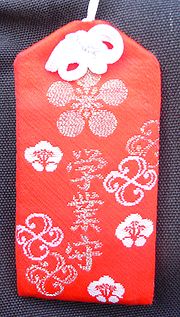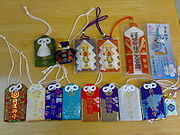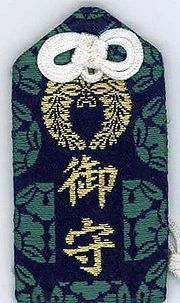
Omamori
Encyclopedia


Amulet
An amulet, similar to a talisman , is any object intended to bring good luck or protection to its owner.Potential amulets include gems, especially engraved gems, statues, coins, drawings, pendants, rings, plants and animals; even words said in certain occasions—for example: vade retro satana—, to...
s dedicated to particular Shinto
Shinto
or Shintoism, also kami-no-michi, is the indigenous spirituality of Japan and the Japanese people. It is a set of practices, to be carried out diligently, to establish a connection between present day Japan and its ancient past. Shinto practices were first recorded and codified in the written...
deities
Kami
is the Japanese word for the spirits, natural forces, or essence in the Shinto faith. Although the word is sometimes translated as "god" or "deity", some Shinto scholars argue that such a translation can cause a misunderstanding of the term...
as well as Buddhist
Buddhism
Buddhism is a religion and philosophy encompassing a variety of traditions, beliefs and practices, largely based on teachings attributed to Siddhartha Gautama, commonly known as the Buddha . The Buddha lived and taught in the northeastern Indian subcontinent some time between the 6th and 4th...
figures
Deva (Buddhism)
A deva in Buddhism is one of many different types of non-human beings who share the characteristics of being more powerful, longer-lived, and, in general, living more contentedly than the average human being....
. The word mamori (守り) means protection, with omamori being the sonkeigo form of the word, "to protect.".
Design and function
The amulet covering is usually made of cloth and encloses papers or pieces of wood or paper with prayerPrayer
Prayer is a form of religious practice that seeks to activate a volitional rapport to a deity through deliberate practice. Prayer may be either individual or communal and take place in public or in private. It may involve the use of words or song. When language is used, prayer may take the form of...
s written on them which are supposed to bring good luck
Luck
Luck or fortuity is good fortune which occurs beyond one's control, without regard to one's will, intention, or desired result. There are at least two senses people usually mean when they use the term, the prescriptive sense and the descriptive sense...
to the bearer on particular occasions, tasks or ordeals. Omamori are also used to ward off bad luck and are often spotted on bags, hung on cellphone straps, in car
Čar
Čar is a village in the municipality of Bujanovac, Serbia. According to the 2002 census, the town has a population of 296 people.-References:...
s, etc. for safety in travel. Many omamori are specific in design to the location they were made.
They often describe on one side the specific area of luck or protection they are intended for and have the name of the shrine or temple
Buddhist temples in Japan
Along with Shinto shrines, Buddhist temples are the most numerous, famous, and important religious buildings in Japan.The term "Shinto shrine" is used in opposition to "Buddhist temple" to mirror in English the distinction made in Japanese between Shinto and Buddhist religious structures. In...
they were bought at on the other. Generic omamori exist, but most of them cover a single area: health, love, or studies, to name only a few. It is said that omamori should never be opened or they lose their protective capacities. Amulets are replaced once a year to ward off bad luck from the previous year. Old amulets are usually returned to the shrine or temple so they can be disposed of properly.


Modern commercial uses
There are modern commercial versions for these that are typically not spiritual in nature and are not issued by a shrine or temple. They do not confer protection or need to be replaced every year. It has become popular for stores in Japan to feature generic omamori with popular characters such as Mickey MouseMickey Mouse
Mickey Mouse is a cartoon character created in 1928 by Walt Disney and Ub Iwerks at The Walt Disney Studio. Mickey is an anthropomorphic black mouse and typically wears red shorts, large yellow shoes, and white gloves...
, Hello Kitty
Hello Kitty
is a fictional character produced by the Japanese company Sanrio, first designed by Yuko Shimizu. She is portrayed as a female white Japanese bobtail cat with a red bow. The character's first appearance on an item, a vinyl coin purse, was introduced in Japan in 1974 and brought to the United States...
, Snoopy
Snoopy
Snoopy is an fictional character in the long-running comic strip Peanuts, by Charles M. Schulz. He is Charlie Brown's pet beagle. Snoopy began his life in the strip as a fairly conventional dog, but eventually evolved into perhaps the strip's most dynamic character—and among the most recognizable...
, Kewpie, etc.
Examples
Some popular omamori are:- Kanai AnzenKanai AnzenKanai Anzen is a type of omamori, or Japanese amulet of the Shinto religion. Its purpose is to promote good health and to help those with illnesses....
: For good health and help with illness. - Kōtsū Anzen: Protection for drivers and travelers of all sorts.
- En-musubi: Available for singles and couples to ensure love and marriage.
- AnzanAnzanAnzan may refer to:* Anshan * Izeh, a city in Iran* Abacus system; 暗算, Japanese mental calculation way by imagination of soroban * A type of japanese amulet, called omamori, used by pregnant women* Ançã , a Portuguese civil parish...
: Protection for pregnant women during term and to ensure a safe and easy delivery. - Gakugyō Jōju: for students and scholars.
- Shōbai Hanjō: Success in business and matters of money.

